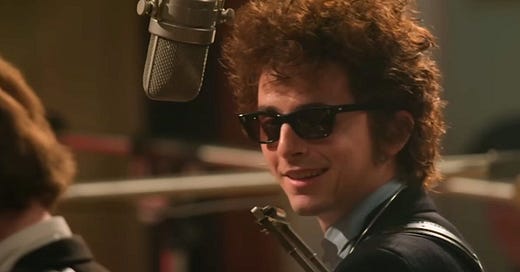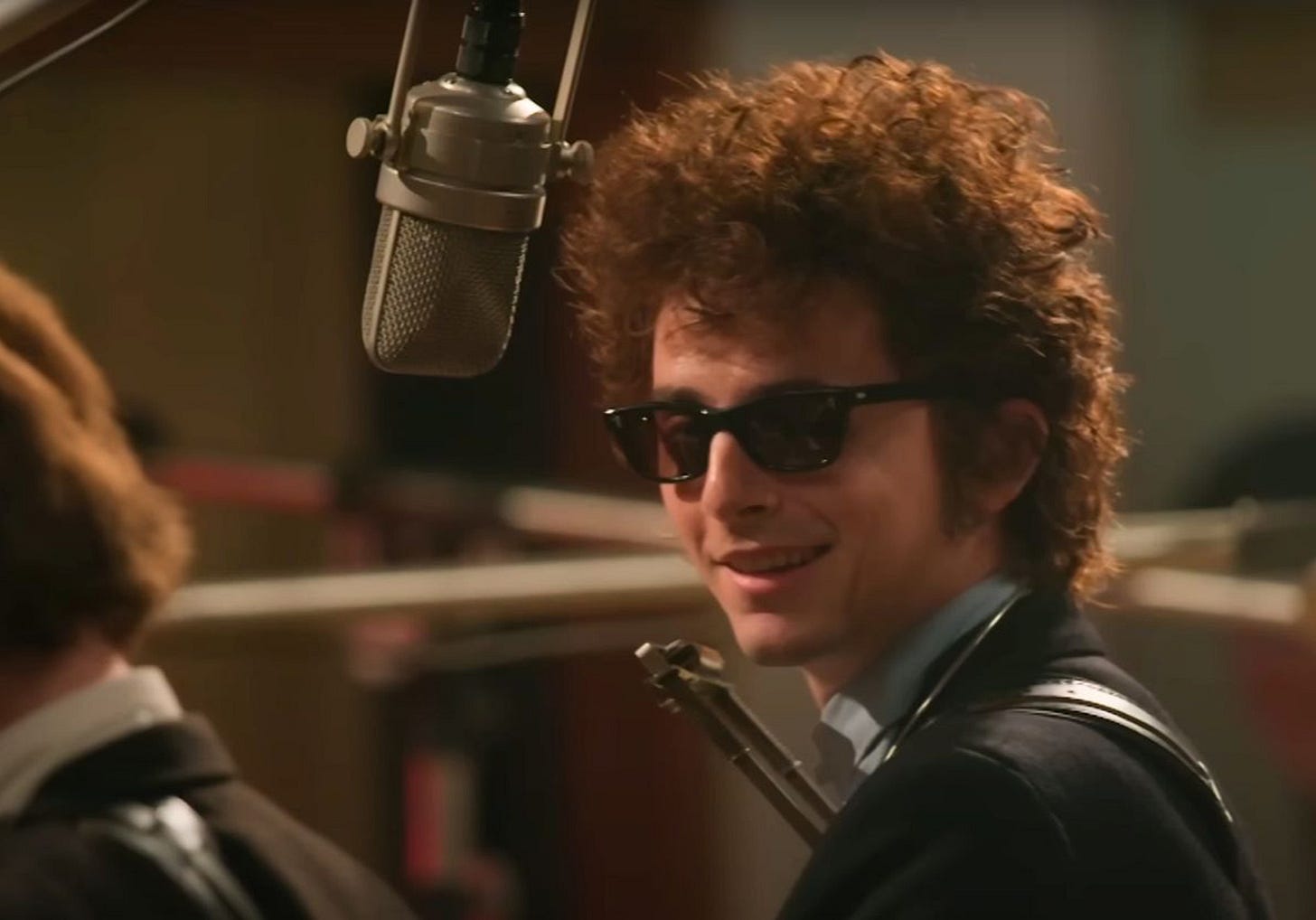So in my last post I talked critically about Bob idolatry, and yet, pot calling the kettle black, there I was last night, a few minutes after midnight, at the head of the line to buy the streaming movie at $30 bucks, something I’ve never done for any other movie. Ever. Then I proceeded to watch the entire thing, two hours and twenty minutes, which went by rather swiftly, I have to say. I completely enjoyed the movie, with slight winces along the way at the historical inaccuracies, but once I let that go and accepted it with a willing suspension of disbelief, it was great.
Make no mistake about it, though, this version of Dylan is a composite story, with large pieces of fiction stitched into the fabric of the real events. Music biopics do this all the time, to condense time for the sake of the movie narrative, and James Manigold’s A Complete Unknown is no different in that respect than most. But hey, it’s a Dylan bio movie, and the three principal actors, Timothy Chalamet, Monica Barbaro, and especially Edward Norton, are all spectacular in their parts. So is Elle Fanning, as the Suze Rotolo substitute, Sylvie Russo, but her character, her influence on Dylan’s early formation as a writer of songs against injustice, is criminally underfeatured in the film.
So. Historical accuracy. Things start off promising, with Woody Guthrie’s voice singing “So Long, It’s Been Good to Know You.” Dylan’s mentor Guthrie, at the beginning of the movie, is in the hospital with Huntington’s disease, and Dylan goes to visit him. But before that happens, the first inaccuracy appears, in the establishing shots of the movie. Dylan, hitching a ride, steps out of a car on a sunny, moderate temperature day in New York, into a bustling streetcorner period scene that’s perfectly recreated by Manigold, a walk-by of the Folk City club, yellow taxis and busy New Yorkers, a guy sitting on the sidewalk with a tambourine in front of him, ok, that’s kind of corny, but it’s very cool overall. Except for the fact that it was January 1961 when Dylan arrived in New York, and one of the coldest winters in some time, a story Dylan recounts in “Talkin’ New York Blues.” (I froze to the bone…) This isn’t incidental, it’s part of the hero’s journey, the young man’s struggle. He was in New York, knew nobody, and it was freezing cold.
Next, in the film, he goes to Greystone Hospital to see Woody, and Pete Seeger is there visiting him. Not true. Also, the film’s Woody can’t speak. Not true again. And not incidental because Woody told Dylan something key about songwriting that affected Dylan’s entire career. He told him to steal. Take a melody, turn it around, use the chords from a good song and write new words to it, take words of an old song and change them around a little. This became Dylan’s working modus operandi since. Presenting a non-verbal Guthrie works visually to emphasize his impairment but forces this essential bit to be left out of the story.
Then comes the requisite time dilation, where Dylan plays a few clubs, gets a rave review from Robert Shelton in the New York Times, gets Albert Grossman as his manager who gets legendary music producer John Hammond to see Dylan and Columbia records signs him. This is played fast and loose, but it’s essentially true enough, though the film, in classic music biopic style, (as parodied brilliantly in Walk Hard) portrays it happening in what seems likes months, though it in fact took a year.
In the midst of this, Timothee Chalamet renders as perfect a Bob Dylan as is humanly possible. The singing and guitar playing, all done by Chalamet live, without dubbing, is especially spectacular. Chalamet doesn’t overdo the distinctive voice, either in songs or speaking. He has Dylan’s clipped, barbed talking voice down, and spares us any easy exaggerations of the voice, which could have quickly ruined the movie.
Edward Norton’s Pete Seeger, who’s by now taken Dylan under his wing, is dead-on perfect. He captures Seeger’s purity of purpose and hardy resilience, his eagerness to calm the waters, a genuinely good man dedicated to change. Dylan musically represents that change, and fulfills it at Newport 1964. In the film, Dylan says, ‘This is a new song,” and sings “Times They Are a Changin,’” causing the crowd of 15,000 to leap to their feet and instantly sing along with the chorus. Emotionally, this is a grabber of a scene. It beautifully shows the scope and passion Dylan’s songs evoked in people at the time, and the galvanizing effect they had.
Except it never happened. Fiction, again. For one thing, the song came out on the Times They are a Changin’ album, in February 1964. So everybody had heard it plenty by the time of the festival, which was held in July. But he didn’t sing it at Newport that year.
Joan Baez enters the movie early, sees Bob in a club, recognizes the same thing Seeger does, and falls in love with him. I’m not sure about the whole historicity of how that happened, but the film does capture the on and off nature of the romance, the difficulty Baez had in dealing with the mercurial Dylan. The Sylvie character becomes aware of the Dylan/Baez affair and is heartbroken, which is historically true enough. Manigold has Sylvie recognize it as Dylan and Baez sing together onstage, and Elle Fanning’s tearful portrayal of that realization is truly heartbreaking.
Monica Barbaro as Baez is another wonder of this cast. Not formerly a singer or guitarist, she effortlessly hits the high soprano notes of Baez’s songs and finger-picks in precise, delicate folk style, capturing her waiflike stage presence as well as her tough, no nonsense persona, in navigating Dylan’s varying moods. There’s a scene where Dylan and Baez are on tour together, and Dylan is becoming sick of singing his old songs, and they publicly argue at the mic over what they’re going to sing next. There was in fact an incident onstage where they apparently argued, but it seems it was more personal than about songs, so this I would call half-fiction.
Around midpoint in the film, though, I didn’t care anymore about the inaccuracies, the sheer exhilarating ride of it was enough. Dylan has taken off, gone into the stratosphere, isn’t about to stand still or stay in the past, and he’s got the stuff to bust everybody’s brains out. We careen into the final scenes, the infamous ‘going electric’ night at Newport. But that too is full of fiction. It wasn’t a last minute choice to go electric. It was well planned, the band had rehearsed that day, and Dylan had every intention to bring the band onstage with him. He knew there’d be blowback, but didn’t anticipate the fury of it, apparently. The woman crying out “Judas” is transplanted fiction - that came later on, at a show in England.
It ends with Bob riding away on this motorcycle, foreshadowing the crash and a whole different chapter in his life.
In other reviews of the movie, I’ve seen complaints that the film doesn’t reveal enough about Dylan, and he remains unknown, which is a cute, puerile aside. I don’t ascribe to that assessment. I think the one thing the film does throughout is show Dylan as being exactly what he says he is - he wants to be a musician and write songs. It’s not mysterious. It’s not enigmatic. He’s right there in front of your eyes, the real Dylan. In real life he’s said it a hundred times, and people still can’t seem to get it. He’s an artist who refuses to stand still and repeat himself. He wrote social justice songs better than anyone. Not But that didn’t mean, to him, that he was a figurehead of social justice, he wasn’t a passionate activist leader, he was someone who studied songs and how to write them. Then he wrote great social justice songs. After that, he wanted to write other great songs of a different sort. So he did. And he’s gone on like that to this day. What’s the mystery? What doesn’t everybody get? All artists go through different periods, if they’re any good. Why’s he an enigma? He’s not. He’s a songwriter.
This is a good movie about Dylan, not the great Dylan movie. What would be the great Bob Dylan biopic? Anyone at Netflix or Apple TV or Max listening, it would be a series, with ten episodes, an hour and a half each, that go in depth into each period and are historically accurate. Let us see a whole episode on the early days, with Dave Van Ronk and Tiny Tim and Odetta and the rotating cast of Gerde’s and other clubs, all vying for the spotlight, and then, one day, it shines on Bob. Then go to episode two.
Like that. Do it like that.





Curious that in a post about the accuracy of the movie, you inaccurately state that Woody Guthrie was in the hospital with Parkinson's Disease. It was, of course Huntington's Disease. I haven't gotten to the rest of the piece yet.
Thanks for the review and making me realize I now 100% have no interest in seeing this film. I believe I've seen everything there is to see about Bob Dylan in documentary form as well as filmed concert appearances and that's enough.